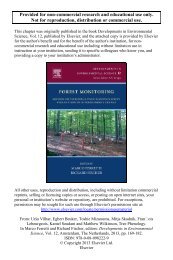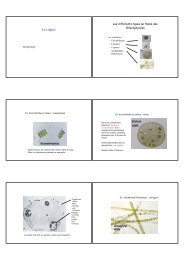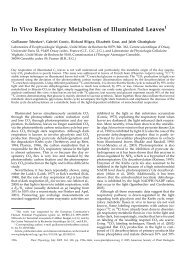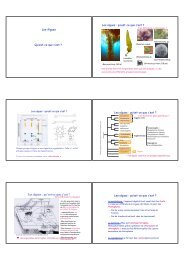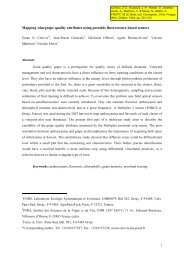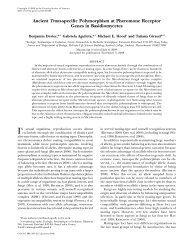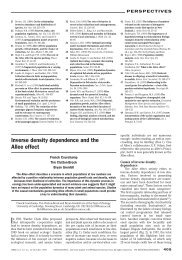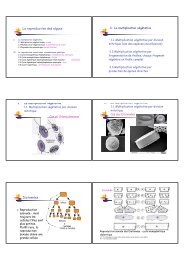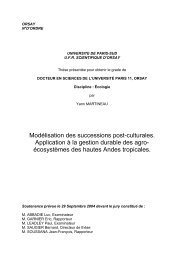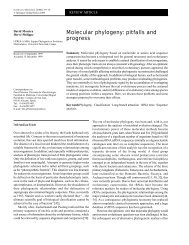Distribution of the anthersmut pathogen Microbotryum on species of ...
Distribution of the anthersmut pathogen Microbotryum on species of ...
Distribution of the anthersmut pathogen Microbotryum on species of ...
Create successful ePaper yourself
Turn your PDF publications into a flip-book with our unique Google optimized e-Paper software.
224 ResearchNewPhytologistFig. 2 <str<strong>on</strong>g>Distributi<strong>on</strong></str<strong>on</strong>g> map <str<strong>on</strong>g>of</str<strong>on</strong>g> all diseased specimens found in this herbarium survey. Red markers, <strong>species</strong> in <str<strong>on</strong>g>the</str<strong>on</strong>g> Caryophyllaceae; blue markers,<strong>species</strong> <str<strong>on</strong>g>of</str<strong>on</strong>g> Calandrinia in <str<strong>on</strong>g>the</str<strong>on</strong>g> Portulacaceae. The map includes specimens with herbarium labels that were legible and c<strong>on</strong>tained locality datamore specific than <str<strong>on</strong>g>the</str<strong>on</strong>g> country <str<strong>on</strong>g>of</str<strong>on</strong>g> origin. C<strong>on</strong>tinents are shaded according to land elevati<strong>on</strong>.Table 3 Frequency <str<strong>on</strong>g>of</str<strong>on</strong>g> disease am<strong>on</strong>g herbarium specimens <str<strong>on</strong>g>of</str<strong>on</strong>g>Sileneae from different c<strong>on</strong>tinentsC<strong>on</strong>tinentforming a sister clade (Fig. 4). O<str<strong>on</strong>g>the</str<strong>on</strong>g>r <strong>species</strong> included in <str<strong>on</strong>g>the</str<strong>on</strong>g>phylogenetic analysis served as ‘c<strong>on</strong>trols’ and, as predicted,sequences <str<strong>on</strong>g>of</str<strong>on</strong>g> <str<strong>on</strong>g>Microbotryum</str<strong>on</strong>g> from herbarium specimens <str<strong>on</strong>g>of</str<strong>on</strong>g>Silene italica and Silene acaulis mapped adjacent tosequences <str<strong>on</strong>g>of</str<strong>on</strong>g> field-collected fungal specimens from <str<strong>on</strong>g>the</str<strong>on</strong>g> samehost <strong>species</strong>. Moreover, sequences <str<strong>on</strong>g>of</str<strong>on</strong>g> an<str<strong>on</strong>g>the</str<strong>on</strong>g>r smut <strong>on</strong> S.chilensis from South America fell within <str<strong>on</strong>g>the</str<strong>on</strong>g> clade c<strong>on</strong>taining<str<strong>on</strong>g>Microbotryum</str<strong>on</strong>g> from o<str<strong>on</strong>g>the</str<strong>on</strong>g>r Silene hosts.Discussi<strong>on</strong>SpecimensexaminedDiseasedspecimensDiseasefrequencyAfrica 1521 12 0.0079Asia 5375 89 0.0166Europe 9123 125 0.0137North America 8709 111 0.0127South America 263 2 0.0076Understanding <str<strong>on</strong>g>the</str<strong>on</strong>g> distributi<strong>on</strong> <str<strong>on</strong>g>of</str<strong>on</strong>g> disease am<strong>on</strong>g relatedhost <strong>species</strong> is a central challenge in <str<strong>on</strong>g>pathogen</str<strong>on</strong>g> ecology, especiallyin <str<strong>on</strong>g>the</str<strong>on</strong>g> c<strong>on</strong>text <str<strong>on</strong>g>of</str<strong>on</strong>g> disease emergence. Here we showthat <str<strong>on</strong>g>the</str<strong>on</strong>g> hosts <str<strong>on</strong>g>of</str<strong>on</strong>g> an<str<strong>on</strong>g>the</str<strong>on</strong>g>r-smut disease, caused by<str<strong>on</strong>g>Microbotryum</str<strong>on</strong>g> <strong>species</strong>, are exclusively perennial plants in <str<strong>on</strong>g>the</str<strong>on</strong>g>Caryophyllaceae. The occurrence <str<strong>on</strong>g>of</str<strong>on</strong>g> an<str<strong>on</strong>g>the</str<strong>on</strong>g>r smut <strong>on</strong>ly <strong>on</strong>perennial plants is c<strong>on</strong>sistent with <str<strong>on</strong>g>the</str<strong>on</strong>g> disease lacking a freelivingor envir<strong>on</strong>mentally resilient overwintering stage, butinstead perennating inside <str<strong>on</strong>g>the</str<strong>on</strong>g> host and being spreaddirectly from diseased flowers to healthy plants primarily byinsect pollinators. This is in c<strong>on</strong>trast to diverse fungal<strong>species</strong> in <str<strong>on</strong>g>the</str<strong>on</strong>g> Microbotryales (Kemler et al., 2006) andUstilaginales (Fischer & Holt<strong>on</strong>, 1957) affecting tissueso<str<strong>on</strong>g>the</str<strong>on</strong>g>r than <str<strong>on</strong>g>the</str<strong>on</strong>g> an<str<strong>on</strong>g>the</str<strong>on</strong>g>rs, such as floral smuts and seed smuts,where transmissi<strong>on</strong> appears to be primarily via spores overwintering<strong>on</strong> <str<strong>on</strong>g>the</str<strong>on</strong>g> seed coat or in <str<strong>on</strong>g>the</str<strong>on</strong>g> soil.Using a search <str<strong>on</strong>g>of</str<strong>on</strong>g> <str<strong>on</strong>g>the</str<strong>on</strong>g> literature, Thrall et al. (1993) als<str<strong>on</strong>g>of</str<strong>on</strong>g>ound that <str<strong>on</strong>g>the</str<strong>on</strong>g> proporti<strong>on</strong> <str<strong>on</strong>g>of</str<strong>on</strong>g> <strong>species</strong> with an<str<strong>on</strong>g>the</str<strong>on</strong>g>r-smut diseasewas far greater in perennials than in annuals. However,in <str<strong>on</strong>g>the</str<strong>on</strong>g>ir study disease was reported in a substantial proporti<strong>on</strong><str<strong>on</strong>g>of</str<strong>on</strong>g> <str<strong>on</strong>g>the</str<strong>on</strong>g> annuals (c. 11% <str<strong>on</strong>g>of</str<strong>on</strong>g> <str<strong>on</strong>g>the</str<strong>on</strong>g> records <str<strong>on</strong>g>of</str<strong>on</strong>g> disease were <strong>on</strong>annual <strong>species</strong>). Unfortunately, <str<strong>on</strong>g>the</str<strong>on</strong>g> original data set fromthat study is no l<strong>on</strong>ger available, but <str<strong>on</strong>g>the</str<strong>on</strong>g> literature reportsmay have included specimens from botanical gardens orexperimental inoculati<strong>on</strong>s. For example, Goldschmidt(1928) records having obtained Silene noctiflora from abotanical garden, and he successfully inoculatedAgrostemma githago experimentally. We have also foundthat annual <strong>species</strong> can become diseased following artificialinoculati<strong>on</strong> (M. E. Hood et al., unpublished results).Similarly, infecti<strong>on</strong> <str<strong>on</strong>g>of</str<strong>on</strong>g> annual <strong>species</strong> in <str<strong>on</strong>g>the</str<strong>on</strong>g> field may resultfrom a transient cross-<strong>species</strong> transmissi<strong>on</strong> involving diseasefrom sympatric perennials, but <str<strong>on</strong>g>the</str<strong>on</strong>g> maintenance <str<strong>on</strong>g>of</str<strong>on</strong>g> disease<strong>on</strong> an annual <strong>species</strong> al<strong>on</strong>e is not expected to occur innature.Previous reports <str<strong>on</strong>g>of</str<strong>on</strong>g> seed-destroying smuts related to<str<strong>on</strong>g>Microbotryum</str<strong>on</strong>g> <strong>on</strong> several annual Silene <strong>species</strong> suggest that achange in <str<strong>on</strong>g>the</str<strong>on</strong>g> <str<strong>on</strong>g>pathogen</str<strong>on</strong>g>’s transmissi<strong>on</strong> ecology may berequired to persist <strong>on</strong> hosts with c<strong>on</strong>trasting life histories(e.g. annual vs perennial). Based largely <strong>on</strong> <str<strong>on</strong>g>the</str<strong>on</strong>g> locati<strong>on</strong> <str<strong>on</strong>g>of</str<strong>on</strong>g>spores and larger spore size, <str<strong>on</strong>g>the</str<strong>on</strong>g> seed-smut <str<strong>on</strong>g>pathogen</str<strong>on</strong>g> <strong>on</strong>annual Silene <strong>species</strong> (i.e. Silene colorata, Silene crassipes andSilene apetala; see Vánky, 2005) was recently removed from<str<strong>on</strong>g>Microbotryum</str<strong>on</strong>g> and renamed Heradaea jehudana (Denchevet al., 2006). Development <str<strong>on</strong>g>of</str<strong>on</strong>g> smut spores in capsules,New Phytologist (2010) 187: 217–229www.newphytologist.comÓ The Authors (2010)Journal compilati<strong>on</strong> Ó New Phytologist Trust (2010)



